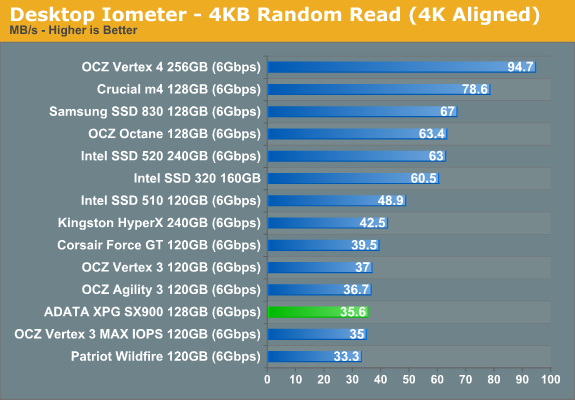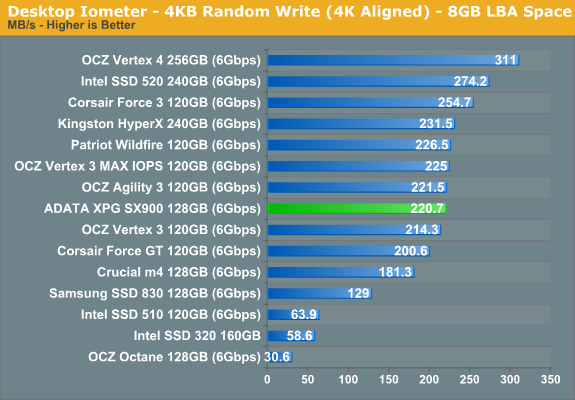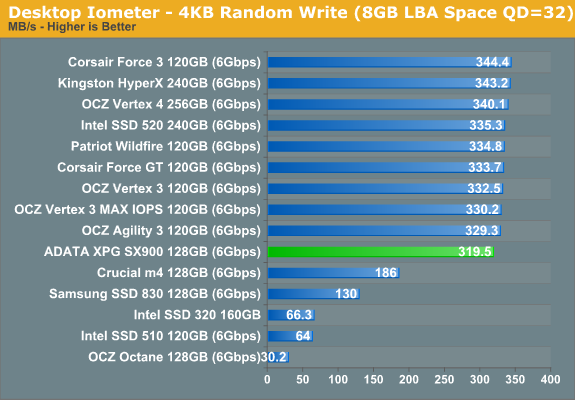ADATA XPG SX900 (128GB) Review: Maximizing SandForce Capacity
by Kristian Vättö on June 8, 2012 1:25 AM ESTRandom Read/Write Speed
The four corners of SSD performance are as follows: random read, random write, sequential read and sequential write speed. Random accesses are generally small in size, while sequential accesses tend to be larger and thus we have the four Iometer tests we use in all of our reviews. Our first test writes 4KB in a completely random pattern over an 8GB space of the drive to simulate the sort of random access that you'd see on an OS drive (even this is more stressful than a normal desktop user would see). I perform three concurrent IOs and run the test for 3 minutes. The results reported are in average MB/s over the entire time. We use both standard pseudo randomly generated data for each write as well as fully random data to show you both the maximum and minimum performance offered by SandForce based drives in these tests. The average performance of SF drives will likely be somewhere in between the two values for each drive you see in the graphs. For an understanding of why this matters, read our original SandForce article.

Random read performance has never been a strength of SandForce as even Intel SSD 320 outperforms most SandForce based SSDs. As the graph shows, the SX900 is on-par with other 120/128GB SandForce drives.

4KB random write performance is no different from other SandForce drives. Only Intel SSD 520 and Corsair Force 3 are noticeably faster, while others fall in the same 215-230MB/s range.

Increasing the queue depth to 32 doesn't change the story. While the SX900 is the slowest SandForce drive in this test, it's less than 5% slower than the majority of SF-2281 drives.
Sequential Read/Write Speed
To measure sequential performance I ran a 1 minute long 128KB sequential test over the entire span of the drive at a queue depth of 1. The results reported are in average MB/s over the entire test length.


Both sequential read and write speeds are almost the same for all SandForce SF-2200 series SSDs and the SX900 is no exception. This isn't a surprise given that the firmware is essentially the same in all SandForce SSDs, with the exception of the Intel 520 series.










58 Comments
View All Comments
vol7ron - Friday, June 8, 2012 - link
If you're going to put Mushkin up there, you might as well put OWC there too. Their drives seem to perform fairly well and are priced "decent"Kristian Vättö - Friday, June 8, 2012 - link
I only put Mushkin there because many have been asking for that since it appears to be one of the cheapest brands. OWC is not cheap, in fact even Vertex 3 is cheaper except the 480GB model. The table is endless if I start putting every brand there, plus checking the prices is PITA and already takes a decent amount of time.StevoLincolnite - Friday, June 8, 2012 - link
Plus... Only 4.52% of the worlds population resides in the USA, so the prices are pretty much useless for the 95.48% of the Earths population that doesn't reside in the US.StevoLincolnite - Friday, June 8, 2012 - link
To add to that, I don't mean to belittle your efforts, I just don't bother to look at the pricing on this site.jak3676 - Friday, June 8, 2012 - link
% of world population is hardly a useful stat to toss out there - you could make a decent argument with % of SSD's sold by country/region, but lets face it 99.99% of the world population (to include the US) isn't buying SSDs.If he listed prices in Euro or CAD or Yen or anything else he'd just be favoring that market (which is probably smaller than the US market anyway). Even if he could list prices available by country for the top 10 markets, he'd just turn off all of us as people wouldn't want to scroll through 10x the number of charts.
nathanddrews - Friday, June 8, 2012 - link
4.52% of the world's population, but 22% of the world's GDP. That's why US prices matter.JarredWalton - Friday, June 8, 2012 - link
And let's not forget that our site's primary readership *is* in the USA. I'm not sure of the breakdown, but I'd guess close to half of all our traffic is US based. Even if it's only 1/3 (Kristian for example is based in Finland), I doubt there's any other currency where our listing SSD prices in that denomination would prove more useful to our readers.Jaybus - Friday, June 8, 2012 - link
Yes, but some two thirds of international trades are in US dollars and it is still the de facto exchange currency.Anyway, what difference does it make? The point is relative prices between drives from different manufacturers. I don't think the ratios would change for different currencies.
djboxbaba - Saturday, June 9, 2012 - link
You realize this is a US based website right? and that the majority of the readership is based in the US?Go to a website that caters to your country's currency if this is a problem for you.
lyeoh - Tuesday, June 12, 2012 - link
Useless? Speak for yourself, some of us in the 95.48% know how to do currency conversion.Are you also going to claim the USD prices of oil, gold, silver, CPUs, DRAMs, etc are useless to the rest of the world?
There's plenty of stuff in the world that are priced in US dollars - as in the manufacturer's/producer's main selling price for the item is in US dollars. And the price in other countries is linked to that USD price. When the USD price goes up, their prices go up too.
If the petrodollar loses its hold (its slipping a bit) then it might make sense to use some other currency. That'll be bad for the USA as the US Gov will no longer be able "tax" other countries just by creating more US dollars.